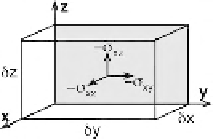Geoscience Reference
In-Depth Information
Appendix 2
Theory of elasticity and elastic waves
When a fixed solid body is subjected to an external force, it changes in size and shape. An
elastic solid
is a solid that returns to its original size and shape after the external deforming
force has been removed. For small deformations and on a short timescale (minutes not
millions of years), rocks can be considered to be elastic.
Stress
Stress is defined as a force per unit area. When a deforming force is applied to a body,
the stress is the ratio of the force to the area over which it is applied. If a force of one newton
(1 N) is applied uniformly to an area of one square metre, the stress is 1 N m
−
2
one pascal
(1 Pa). If the force is normal (perpendicular) to the surface, then the stress is termed a
normal
stress
;ifitistangential to the surface, the stress is termed a
shearing stress
. Usually, the force
is neither entirely normal nor tangential but is at some arbitrary intermediate angle, in which
case it can be resolved into components normal and tangential to the surface; so the stress is
composed both of normal components and of shearing components. The sign convention is
that tensional stresses are positive and compressional stresses negative.
Now consider a small parallelepiped with sides
x
,
y
and
z
(Fig. A2.1) and imagine that
it is being stressed by some external force. On each face, the stresses can be resolved into
components in the
x
,
y
and
z
directions. The stresses acting on the shaded face are
-
σ
xx
,
-
σ
xy
and
-
σ
xz
. The notation is that
σ
xy
refers to the stress
σ
acting in the
y
direction on the face
which is perpendicular to the
x
axis. The
normal stress
is thus
-
σ
xx
and the
shearing stresses
are
-
σ
xy
and
-
σ
xz
.
≡
Figure A2.1.
If the parallelepiped is to be in
static equilibrium
(not moving), then the stresses on
opposite faces must balance, and there must be no net couple that would rotate the
parallelepiped. This requires that the stresses on opposite faces be equal in magnitude and
opposite in direction. The shearing stresses on opposite faces of the parallelepiped (e.g.,
-
σ
xy
and
σ
xy
on the back and front faces as shown in Fig. A2.1) provide a couple that will rotate the
parallelepiped. Since the parallelepiped must not rotate, this couple must be balanced by the
couple provided by the shearing stresses
-
σ
yx
and
σ
yx
acting on the two side faces. This means
that
σ
xy
must equal
σ
yx
. The same conditions apply to the other shearing stresses:
σ
xy
=
σ
yx
,
σ
xz
=
σ
zx
and
σ
yz
=
σ
zy
(i.e., the stress tensor must be symmetrical).
620

